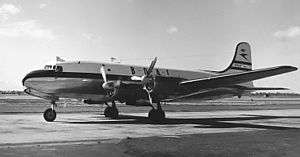Flight into Danger
| Flight Into Danger | |
|---|---|
 Promotional poster | |
| Directed by | Gabriel Axel |
| Produced by | David Greene |
| Written by | Arthur Hailey |
| Starring |
|
| Cinematography | Len Macdonald |
Production company | |
| Distributed by | Canadian Broadcasting Corporation (CBC) |
Release dates |
(broadcast date) |
Running time | 60 minutes |
| Country | Canada |
| Language | English |
| Budget | $18,000 (Canadian) |
Flight into Danger is a 1956 Canadian television film starring James Doohan [N 1], Corinne Conley, Kate Reid, Zachary Scott and Philip Gilbert. It was written by Arthur Hailey, produced and screened by CBC Television, and broadcast on April 3, 1956, on the General Motors Theatre series.
Plot
While on a flight from Toronto, Ontario, to Vancouver, British Columbia, the pilots at the controls of a Canadair North Star, a large commercial airliner, fall victim to food poisoning. Approximately half of the passengers have also been incapacitated by eating the same fish served to the pilots. After the stewardess (Corinne Conley) asks for help from the passengers, George Spencer (James Doohan), an ex-Second World War Spitfire fighter pilot, is forced to take over. His wife (Kate Reid) is able to help him at the controls, but he is worried about his sick son. A storm over Vancouver makes matters worse, with George not only having to overcome harrowing wartime flashbacks, but also struggling with the controls of an unfamiliar aircraft, in order to bring the airliner down safely.
Cast
- James Doohan as George Spencer[N 2]
- Corinne Conley as Stewardess
- Kate Reid as Mrs. Spencer
- Cec Linder as Martin Treleaven
- Zachary Scott as Captain Dunning
- Philip Gilbert as Co-pilot Stewart
- Sandy Webster as Dr. Frank Baird
Production

Playwright Hailey, a former British pilot in the Second World War, immigrated to Canada in 1947. He began working as a sales promotion manager for a tractor-trailer manufacturer in Toronto. On a flight between Vancouver and Toronto in 1955, he came up with the original idea that spawned Flight into Danger. The story of an airliner whose passengers and crew were threatened by an unforeseen event such as food poisoning was written in only nine days and shopped about as a screenplay.[2] The Canadian Broadcasting Corporation, barely four years old, bought the script for $600.[3]
The production acquired the cockpit of a Royal Canadian Air Force (RCAF) Canadair North Star and had it shipped by road to RCAF Station Trenton, where the filming took place, including aerial shots. The Malton Airport at Malton, Ontario, a town near Toronto, was also used for the airport scenes.[4]
Reception
When Flight into Danger was broadcast live-to-air on April 3, 1956, on the network's General Motors Theatre, it was seen by two million people and received a resounding positive reaction. "In the words of one journalist, it was 'probably the most successful TV play ever written anywhere'."[5] After being shown with a new cast and production staff on NBC's anthology series The Alcoa Hour on September 16, 1956, the original play was purchased for screening by the BBC in the United Kingdom and was a major factor in the supervising producer of CBC's television dramas, Sydney Newman, being brought across to work in the UK. There he made a significant impact on the British television drama industry.[6]
In 1957, Flight into Danger was adapted into the feature film Zero Hour! and, in 1962, the story was adapted for an episode of the BBC series Studio 4.[3] In 1964, a German version of the television film was produced under the title Flug in Gefahr. Czechoslovak radio (Československý rozhlas) has produced it as part of the radio series Let do nebezpečí, directed by Jiří Horčička.
In Flight into Danger, Hailey created the template for future disaster films.[7] Character-driven plot lines built up among diverse characters would dominate, with brief episodes or flashbacks giving back stories, and all the individual stories coming together at the climax.[8] Hailey and John Castle novelized the story as Runway Zero-Eight (1958), which was dramatized in 1971 as Terror in the Sky, a Movie of the Week. The story was more famously parodied in the 1980 comedy Airplane!.[6]
References
Notes
This story was converted into a book, Runway Zero-Eight, published in paperback 1966 (Hailey and Castle). Copyright listed as 1958: Arthur Hailey, Ronald Payne, and John Garrod.
- ↑ Doohan later became famous as "Scotty" in Star Trek: The Original Series.
- ↑ Doohan was a wartime pilot flying Taylorcraft Auster Mark V aircraft for 666 (AOP) Squadron, RCAF as a Royal Canadian Artillery officer.[1]
Citations
- ↑ Fromow 2002, p. 45.
- ↑ Barker, Dennis. "Obituary: Arthur Hailey." The Guardian, November 27, 2004. Retrieved: September 7, 2014.
- 1 2 "Arthur Hailey". ABC Bookworld. Retrieved: September 6, 2014.
- ↑ Hailey 2014.
- ↑ Plummer, Kevin. "Hailey's Comet." Historicist, August 13, 2011. Retrieved: September 6, 2014.
- 1 2 Cady, Brian. "Zero Hour." Turner Classic Movies. Retrieved: September 6, 2014.
- ↑ Kay and Rose 2006, p. 48.
- ↑ Sparber 2011.
Bibliography
- Fromow, D. L. Canada's Flying Gunners: A History of the Air Observation Post of the Royal Regiment of Canadian Artillery. Ottawa, Ontario, Canada: Air O.P. Pilot's Association, 2002. ISBN 0-9730055-0-5.
- Haliley, Sheila. I Married a Best Seller: My Life with Arthur Hailey. New York: Open Road Media, 2014. ISBN 978-1-48049-004-8.
- Kay, Glenn and Michael Rose.Disaster Movies: A Loud, Long, Explosive, Star-studded Guide to Avalanches ... Oakville, Ontario, Canada: Mosaic Press, 2006. ISBN 978-1-55652-612-1.
- Sparber, Max. Ultra-Actors: William Shatner. Seattle, Washington: Ultramod, 2011. ISBN 978-1-45803-457-1.